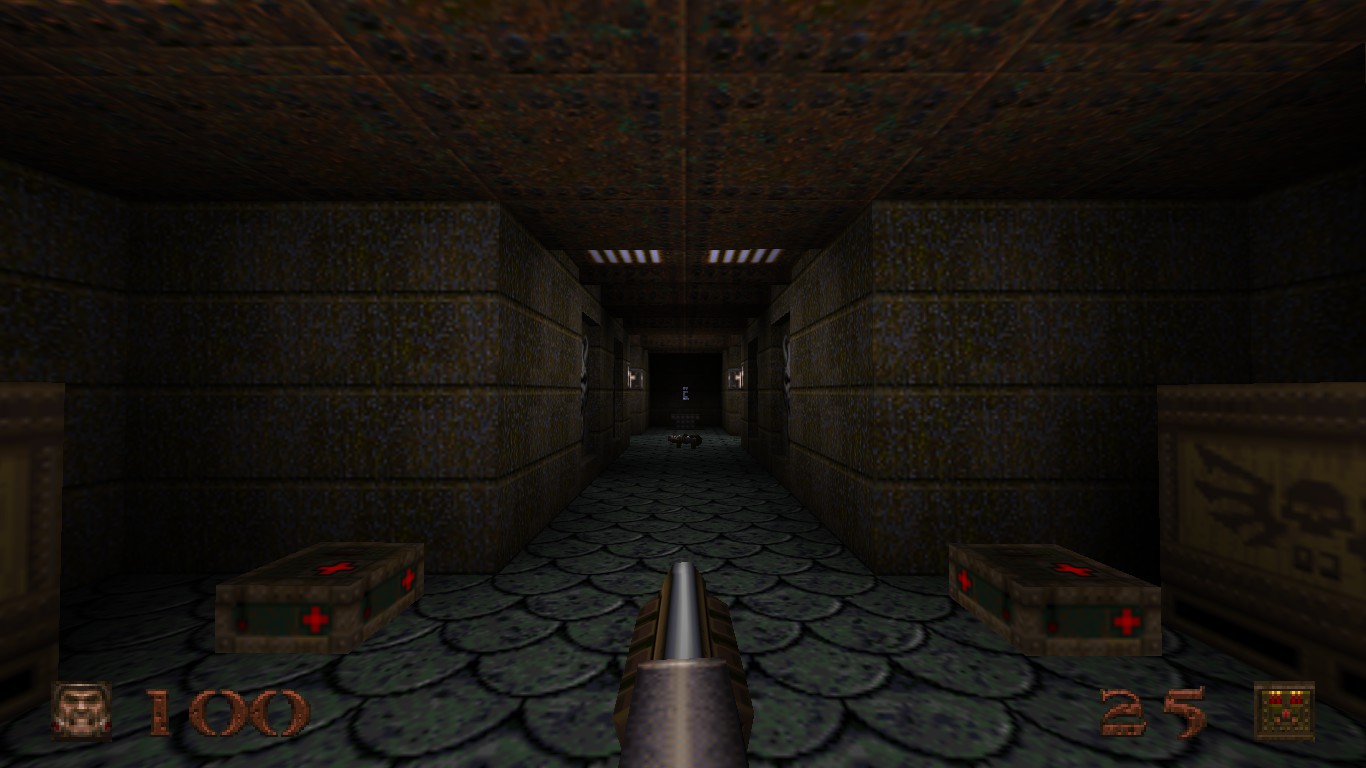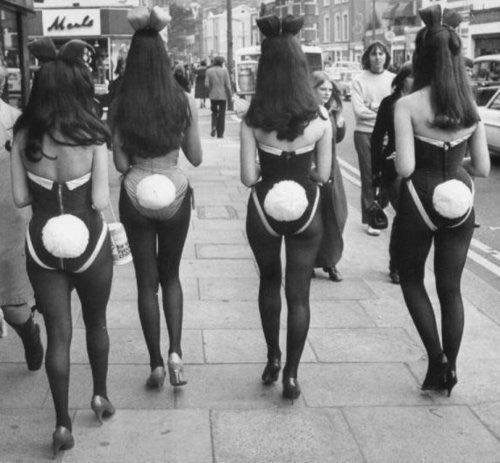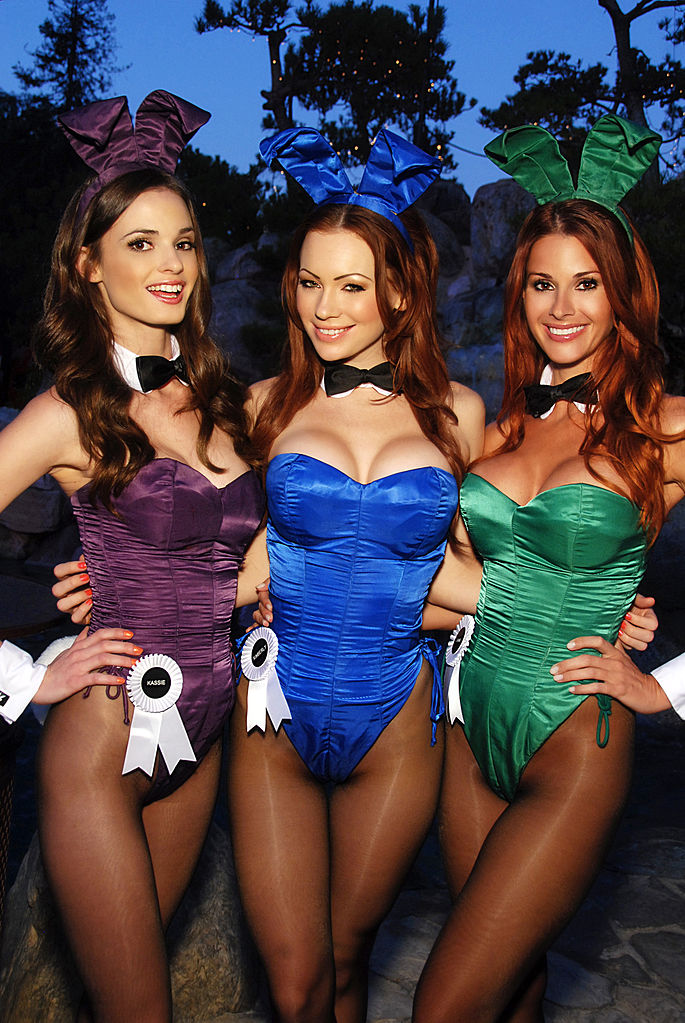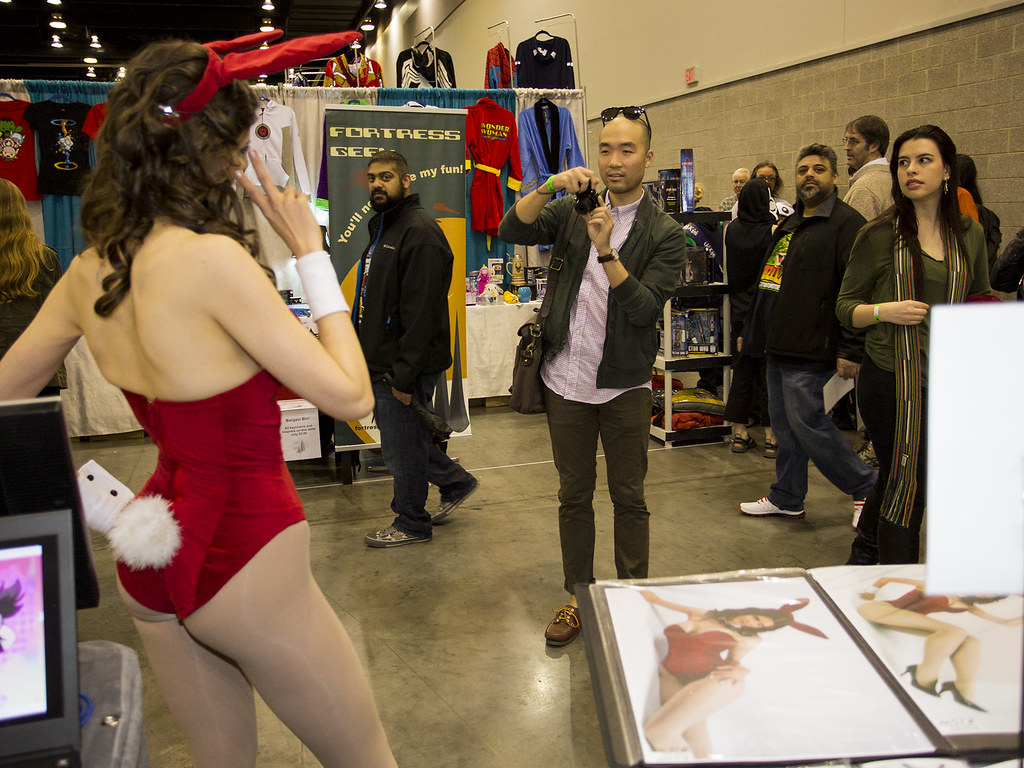A Dark Humour Rube-Goldberg Machine
At first there was a weird dream, and I no longer remember the context because dreams are usually a randomised mish-mash of things going on in your life, but this dream was about a guy being stuck in an infinite series of death-traps, respawning after every death. It’s likely this was because I had been playing Quake, as I had imagined this guy being like Doomguy (from DOOM) or Ranger (from Quake).
When I awoke, I thought it was rather weird, but an unusual thought-experiment; what would be the reason for such a predicament, and what kind of character would it build?
Quake’s dark, oppressive atmosphere and theme of human technology bleeding into eldritch worlds has yet to be replicated in any other game.
This idea sat in the back of my mind for a year whilst I ruminated about the specifics; being a dark god’s plaything is essentially the whole plot of Quake III, a game notable at the time for having basically no plot (“kill or be killed”). A character that was used to death, to the point where they would ignore it, would use the intervening moments to plot the downfall of their captor.
Quake III eschewed the single-player campaign and plot in favour of pure multi-player death-match arena. The intro video shows the character Sarge being teleported away from certain death.
I thought that this idea had merit, perhaps as a short story, where the character’s continuous narration would be arbitrarily interrupted by descriptions of the ever more varied and inventive death-traps. A dark-humour take on a Rube-Goldberg machine, if you will.
West Meets East
At this point, it’s just guesswork how the idea went from your typical space-marine character to a woman and a bunny-girl specifically. Given the development time-frame, it must have been around Easter, when the Internet’s artists collectively have a need to draw every popular character going in a bunny-suit, and these stream by Reddit and Twitter alike every year.
I don’t recall any particular image, but I do recall the exact inspiration it gave me: A Doomguy-like übermensch is uninteresting exactly because he’s an emotionless tool who would choose to grit his teeth and bear it whilst brewing up the mother of all grudges. A woman however, being a creature of emotion, is infinitely more interesting; far more nuanced. Add the bunny-suit and you’ve got a wild juxtaposition that raises many questions and answers none.
My character had to be a cosplayer and/or Japanese, and I say that because of the vast cultural differences between how bunny-girls are perceived in the U.S. vs. Japan:
A Star Is Born
The Playboy Bunny Girl costume was the first ever registered commercial uniform in the United States (1963). This afforded it a high amount of trademark protection which is why the bunny-suit, and the bunny-girl image as a whole, is solely associated with Playboy; and notwithstanding America’s particular brand of “moral outrage” at anything pertaining to sex, meant that one was not likely to observe a bunny-girl in any public context (such as on TV) outside of official Playboy activities.
Naturally, Playboy advertised the bunny life-style as being glamorous and empowering; providing freedom for the bunnies to work as they pleased. The truth of the matter was exposed when a journalist went undercover as a bunny-girl in 1963 and discovered the usual corporate two-faced hypocrisy – the exposé is a fascinating look into the past and well worth a read online in parts one and two.
This advert extolled the virtues of being a Playboy Bunny, including supposed pay that would be the equivalent of $1800~$2700 in 2021. Like any such advert, nobody actually earned that much and the job was nowhere near as glamorous as it was made out to be. Source: A Bunny’s Tale, Show Magazine, May 1963.
Whether considered symbols of female empowerment or female enslavement, other similar master-strokes of mid-Century fashion design such as the bikini and the mini-skirt went on to endure and the bunny-suit kind of just fizzled out; stymied by its corporate guardian; unable to keep up with the times. By 1988, the Bunny Girl was a relic of the ’60s & ‘70s past and didn’t fit in the new world of neon-coloured Lycra & Spandex and the concept was retired.
Playboy Bunnies going for a walk in 1970s London, England. Image © RV1864.
The trademark having expired in 2004 meant that anybody could make a “bunny girl” costume and it wasn’t long until the design had been watered down to the point that the once proud symbol of glamour has, in recent times, become the exclusive haunt of tacky Halloween costumes.
Thus, in the West, the bunny-suit has been reduced to a cliché of itself; like everything that once stood for class & luxury – e.g. hot-tubs, swimming pools & limousines – once in the hands of the masses, has given way to crass economy.
In the East, however, the bunny-suit has gone on to better things…
The Land of the Rising Sun
Free of the U.S. trademark in a country that has, how shall we say… less Christian… ideas about the female body, the bunny-suit managed to persist as an image of beauty in Japan’s strong idol industry and entered the national consciousness via cross-pollination of all other forms of media: manga, anime, TV and magazines.
Whilst hardly normal, it wouldn’t be unusual to see a bunny-girl anywhere a typical “glamorous assistant” would be required; prize-giving ceremonies, sports events and the always eternal (ready to be sawn in half) magician’s assistant.
One could just as easily come across a bunny-girl in kids media as in adult media and yet the Japanese psyche is not at all conflicted by this. In contrast, American parents had a collective aneurism when a famous kids TV actor did an artistic semi-nude photo-shoot for a glossy magazine. Unless Vanity Fair has a particularly strong readership amongst six year olds, the protesters did far more to bring the news to the fore than to ‘keep the children from viewing this smut’.
Cosplay
With Japan’s unique agnosticism over the shock-factor of bunny-girls; able to be both family friendly and adult at the same time (and ne’er the twain shall meet), its dissemination into manga and anime was certain. Whilst anime and manga are everyday pedestrian normalities in Japan – as normal as 24-hour news and billboards in the U.S.A. – the voracious appetite for all things Japan in the West is filtered down and funnelled into an intense sub-culture that can look strange and perverse from the outside.
“Cosplay” is the activity of dressing up as fictional characters; although that undersells the nature of it, there being a whole subculture surrounding the practice; and given the strong ties between geek/nerd-culture and Japan, the bunny-suit has been re-exported to the West via anime, and cosplay there of. It’s safe to say that the bunny-girl of 2021 is almost entirely a Japanese creation and I do wonder if Gen-Z anime fans & cosplayers are even aware of the bunny girl’s origin as an extension of America’s mid-Century club / cabaret culture.
Playboy tried to revive bunny-girl clubs multiple times in the mid 2000s and 2010s, each time being met with failure. Image © Glenn Francis, www.PacificProDigital.com via Wikimedia Commons
Why would my character be wearing a bunny-suit and why would it have anything to do with being trapped in a personal hell that could possibly be justified outside of [or be perceived as] anime logic, sadism, or just plain misogyny?
Of course the obverse of the misogynistic argument is fuck you, women are allowed to wear a bunny-suit if they so please; men shouldn’t be telling them what they can and can’t wear. I can remember two specific instances of this kind of thing happening recently: when E3 cancelled “booth-babes” and some on Twitter were livid that they were being cancelled for being female, and Formula 1 cancelling “grid girls” likewise, taking away a paying job they enjoyed.
Exploitation or empowerment? Image © Kay Pike Fashion
I knew I wanted to convey a realistic character within the structure of a simple, but unrealistic (improbable? larger-than-life?) scenario and whilst I hadn’t initially thought of a bunny-suit, it would put several tropes on the table that I fully intended to subvert. For every trope that appeared on the surface I wanted a resounding counterpoint.
There are cosplayers who have put blood, sweat and tears into hand-crafting their own bunny-suit to cosplay their favourite character and I wanted to capture that sincerity.
If my character were English or American, then cosplay would be one answer why the character would be wearing a bunny-suit that wouldn’t make them a Playboy Bunny Girl by default. If my character were Japanese then there could be multiple reasons (including cosplay) why they would be wearing a bunny-suit, but I didn’t consider myself knowledgeable enough to write a purely Japanese character (and even less so an actual Playboy Bunny Girl), so I opted for a woman that was caught between East & West, being half Japanese and half English.
The Man In The Mirror
I started working backwards in fleshing out the character. If a dark god had snatched our character away, under what circumstances, and why?
If this was ever to become a game then there must be a way to escape, but how can we expect a human to over-power this impossible construction of a god?
If the prison’s traps were not merely random, but a reflection of the character, then the prison would be a meta-physical commentary on their forgotten past and an exit could be conceived by remembering their past and what led them there. That is, if the prison reflected the character, then the character changing themselves would also change the prison and could feasibly effect an escape.
Likewise, if the prison were a reflection of the person, then I didn’t want a bad person who deserved what was coming to them, but someone who had found themselves there through misfortune, mistake – the normal human predilection for selfishness and short-sightedness.
The idea that the prison and its traps could be metaphors was a major breakthrough in the realisation of a story that was whole, rather than just ‘a bit in the middle’ as is typical of most of my game ideas – the juicy bit, but with no starter or dessert.
(Side note: It had never occurred to me once that the whole ‘tortured forever by a dark god’ plot could be interpreted as having gone to hell until I included a Bible in the design as part of a puzzle, but I will stress this is not an intended theme of the game despite the obvious fit)
The character’s name came from that important idea of self-narrative from the beginning; here’s a snippet of text I wrote to explore the narration that might form the opening of the game:
To whom it may concern.
(No, that's not right, don't be so stuffy)
Hello.
(That's better)
Hello. My name is
(I don't know; I forgot it. That's hardley a good introduction, is it? It's so difficult to know where to begin!)
Hello. I am Bunny.
(That's better)
I've been imprisoned.
(That's good; gets straight to the point)
Except this isn't a real prison, well, I mean, I doubt it exists in a "real" sense because it's probably not a part of normal space & time.
(That's not going to make any sense!)
OK. I was imprisoned by a dark god for crimes of which I don't know or remember, if I had committed any crimes at all!
(Exactly!)
In this "prison" there are no walls, just a seemingly infinite darkness. There's nowhere to escape to.
(I've tried, it never goes well)
My "punishment" is being killed over and over again; that is to say that every time I die, I discover myself alive, again, ready for the next time.
(I need to be more specific, the details won't be apparent to somebody else)
I have been blown-up, crushed, smashed, burnt, sliced and skewered through every conceivable angle. It hurts every time.
I'm embarrassed to say that the reason why I've forgotten why I'm here, or who I was before, is because when I did arrive I was terrified and weak, and made the mistake of trying to apologise, bargain, threaten and generally reason my way out of the endless horror of my predicament, but the bloody and violent deaths came anyway. Every time I cried, trembled and wet myself in fear, and every death was sudden, unexpected and unbearable.
I lost my mind for some time.
Fear had so completely taken over that I just 'existed', coasting along on emotion only, unable to form a complete thought or string a sentence together. I was too caught up in the fear of the full expectation I was going to die at any moment and the terrible, paralysing anticipation of waiting for it to happen.
I forgot who I was and even forgot that I was the same person each time! Death after death, as if it were the first!
Slowly, (I don't recall how), I began forming a continuous thread of thought again between deaths, and eventually became self-aware once more -- If it's not instant, then I get between 5 seconds and a minute between each in which to think.
In fact, I'm writing my story in my head as I go, to pull myself together, keep sane, and hopefully remember who I am. If a dark god is getting amusement from my imprisonment then I can only hope that a good god, somewhere, is hearing these thoughts and can save me.
I lost myself for a few years there at the start. I've been here almost a couple decades now, maybe. Sorry, that's what I meant by being outside time.
Now tell me, if you’ve never made a computer game before, what would it take for you to drop everything you’ve got going on and begin working on it? A neat idea is not alone enough; there’s a vast difference between “I’ve got a great idea for a game!” and one’s ikigai – reason to wake in the morning. It takes something special to be so deeply compelling that you’re willing to beat the imagination out of your head and into tangible artefacts.
For me, that moment came as a flash of inspiration: these metaphors for the in-game character could also be my metaphors. It is said that everybody’s first novel is semi-autobiographical; that one draws upon what they know best. For several years now I have been unable to properly articulate the struggles I have had with something I learned of, about myself, that completely turned my perception of life upside down and even knowing ahead of time that I would be facing the Five Stages of Grief: denial, anger, bargaining, depression and acceptance; I still had to go through them all.
That pain was my ikigai. That’s what drove me to start this game, what drives me to keep pushing forward with it. To be able to articulate, in metaphor, what has been troubling me for so long. I’m not going to reveal what the true meaning of this metaphor is; partly because it’s simply not nearly as severe as might be imagined by my not revealing it, but also partly because I think it will be obvious to some when they play the game, and I will await the first correct guess before I explain myself.
That said, this is still a game, and a game about a character, and that character isn’t me. I’ve written almost 8’000 words detailing Bunny’s background and history (even covering her parents lives); her upbringing, and the major events in her life that shaped her and lead up to where the game actually begins: her standing atop the office building, in a bunny-suit, hands covered in blood, contemplating suicide, when a dark god offers her another chance…
That’s all I can write for now, but in the next devlog we’ll begin looking at the choice of technology and development tools.
Die, Bunny, Die!
Doomed to die endlessly in a metaphysical prison; why is she there, can she escape, and why is she wearing a bunnysuit?
| Status | In development |
| Author | Kroc Camen |
| Genre | Adventure, Interactive Fiction |
| Tags | Female Protagonist, Mystery, Text based |
| Languages | English |
More posts
- I Wandered Lonely As A CloudSep 01, 2021






Leave a comment
Log in with itch.io to leave a comment.